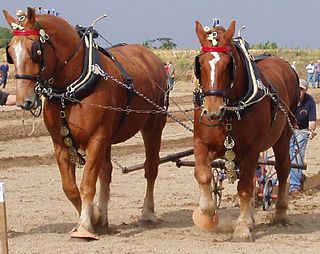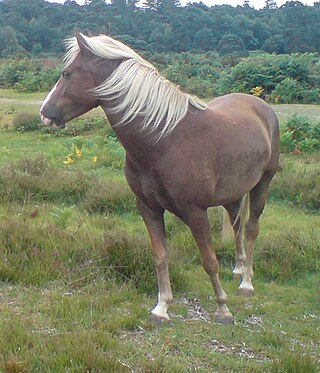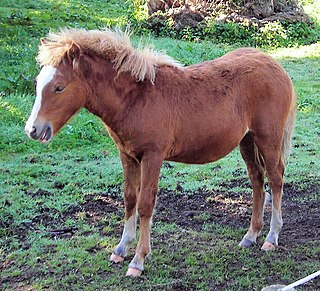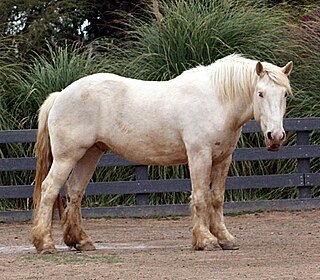
The Konik or Polish Konik is a Polish breed of pony. There are semi-feral populations in some regions. They are usually mouse dun or striped dun in color.

The Clydesdale is a Scottish breed of draught horse. It is named for its area of origin, the Clydesdale or valley of the River Clyde, much of which is within the county of Lanarkshire.

The Suffolk Horse, also historically known as the Suffolk Punch or Suffolk Sorrel, is an English breed of draught horse. The first part of the name is from the county of Suffolk in East Anglia, and the word "Punch" is an old English word for a short stout person. It is a heavy draught horse which is always chestnut in colour, traditionally spelled "chesnut". Suffolk Punches are known as good doers, and tend to have energetic gaits.

The New Forest pony is one of the recognised mountain and moorland or native pony breeds of the British Isles. Height varies from around 12 to 14.2 hands ; ponies of all heights should be strong, workmanlike, and of a good riding type. They are valued for hardiness, strength, and sure-footedness.

The Canadian is a horse breed from Canada. It is a strong, well-muscled horse, usually dark in colour. It is generally used for riding and driving. Descended from draft and light riding horses imported to Canada in the late 1600s from France, it was later crossed with other British and American breeds. During the 18th century the Canadian horse spread throughout the northeastern US, where it contributed to the development of several horse breeds. During the peak popularity of the breed, three subtypes could be distinguished, a draft horse type, a trotting type and a pacing type. Thousands of horses were exported in the 19th century, many of whom were subsequently killed while acting as cavalry horses in the American Civil War. These exports decreased the purebred Canadian population almost to the point of extinction, prompting the formation of a studbook and the passage of a law against further export.

The Dales Pony is a British breed of pony or small horse. It originated in, and is named for, the Dales of Yorkshire in northern England. It is one the nine native mountain and moorland pony breeds of the United Kingdom, and belongs to the broader Celtic group of ponies which extends from Portugal and northern Spain to Scandinavia.

The Exmoor Pony is a British breed of pony or small horse. It is one of the mountain and moorland pony breeds native to the British Isles, and so falls within the larger Celtic group of European ponies. It originates on, and is named for, the Exmoor area of moorland in north-eastern Devon and western Somerset, in south-west England, and is well adapted to the climate conditions and poor grazing of the moor. Some still live there in a near-feral state, but most are in private ownership.

The Knabstrupper or Knabstrup is a Danish breed of warmblood horse. It is principally a riding horse, but is also used as a harness horse and as a circus animal. The breed usually has a spotted coat. Injudicious breeding for this characteristic alone compromised its constitution and conformation; in the years after the Second World War the mechanisation of agriculture led to a sharp fall in numbers, and by the 1960s no more than 100 horses remained. In the twenty-first century it is an endangered breed, with a world-wide population estimated at little over 2000.

The Kerry Bog Pony is a mountain and moorland breed of pony that originated in Ireland. Possibly descended from the Irish Hobby horse, it originally lived a mainly feral existence in the peat bogs of what is now County Kerry in southwestern Ireland. Local inhabitants used the ponies as pack and cart horses for transporting peat and kelp to the villages. The breed developed physical characteristics including a low weight-to-height ratio and an unusual footfall pattern, which helped it move on soft ground such as peat bogs. The ponies were known for hardiness and an ability to survive in harsh conditions.

The American Cream Draft is an American breed of draft horse, characterized by the cream or "gold champagne" color of its coat. It was developed in Iowa during the early twentieth century from a cream-colored mare named Old Granny. A breed registry was formed in 1944 but became inactive for several decades when breed numbers dropped due to the mechanization of farming. It was reactivated in 1982 and population numbers have slowly grown since then. It is a rare breed: its conservation status is considered critical by The Livestock Conservancy and the Equus Survival Trust.

The Novokirghiz or New Kirghiz is a modern Kyrgyz breed of horse. It was developed in the Kirghiz Soviet Socialist Republic in the mid-twentieth century through cross-breeding of the traditional Kyrgyz Horse of the region with introduced horses of Thoroughbred, Don and Anglo-Don stock.
The Tawleed is a Sudanese breed of sport horse. It derives from the Sudanese Country-Bred through cross-breeding with imported blood horses, principally of Thoroughbred stock. It is found mainly in the Khartoum region of Sudan.

The Heck horse is a horse breed that is claimed to resemble the tarpan, an extinct wild equine. The breed was created by the German zoologist brothers Heinz Heck and Lutz Heck in an attempt to breed back the tarpan. Although unsuccessful at creating a genetic copy of the extinct species, they developed a breed with grullo coloration and primitive markings. Heck horses were subsequently exported to the United States, where a breed association was created in the 1960s.
Western Sudan Pony is an exonym for a Sudanese breed or group of breeds or ecotypes of small horse or pony. These are distributed principally in southern Darfur and south-western Kordofan, extending into southern Chad, and are known generically as Gharbaui ("western") or by a variety of regional names including Darfur Pony and Kordofani.

The British Spotted Pony is a British breed of pony characterised by a spotted coat. The height at the withers does not exceed 147 cm.
The Blue Albion was a British breed of cattle with an unusual blue roan coat. It originated in the English Midlands in the late nineteenth or early twentieth century, and was a dual-purpose breed, reared both for beef and for milk. It became extinct following the foot-and-mouth outbreak of 1967.

The Kiso or Kiso Horse is one of the eight indigenous horse breeds of Japan. It is the only native horse breed from Honshu, the principal island of Japan. Like most other Japanese native breeds, it is critically endangered.

The Lac La Croix Indian Pony (LLCIP), also known as the Ojibwe pony is a semi-feral Canadian horse breed developed by the Ojibwe people. The population became critically low; and, by 1977, only four mares remained. To preserve the breed, these mares were crossed with Spanish Mustang stallions. The modern breed name derives from the Lac La Croix First Nation of Ontario, where the horses were last found in the wild. Historically, the breed was also found in Minnesota.

The Strelets Arab or Strelets Horse is an extinct Ukrainian breed of light cavalry horse. It was bred in the nineteenth century at the Striletsky State Stud in Luhansk Oblast of Ukraine, from Arab and a variety of other stock. As with other Russian horse populations, its numbers were gravely reduced by the events of the Russian Revolution and the Russian Civil War, and it came close to disappearing. Two stallions and a few mares survived, which was judged to be too small a number to allow the breed to be recovered. Instead, they were taken to the Tersk Stud in the North Caucasus and used as the foundation stock in the development of the new Tersk breed of riding horse. The Strelets also contributed to the development of the Don and Kustanai breeds.
The Sudanese Country-Bred is a Sudanese breed of light riding horse. It was bred in the twentieth century by cross-breeding local mares of Barb type with imported Arab or Thoroughbred stallions.

















